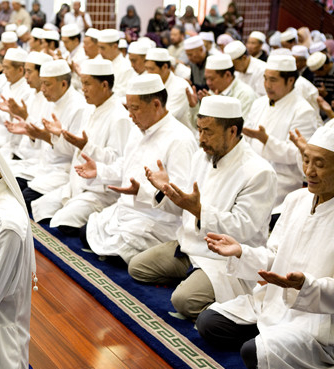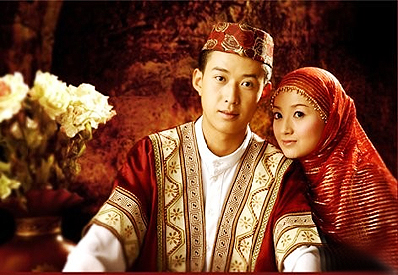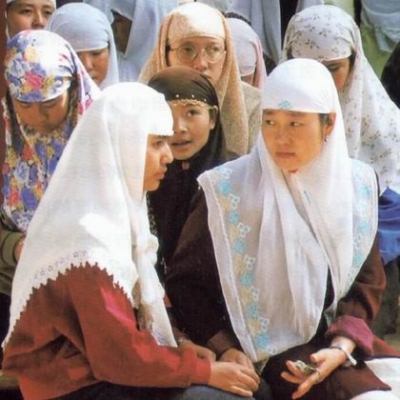
Deutsch-Chinesische Enzyklopädie, 德汉百科
 *National minorities in China
*National minorities in China











达斡尔族是中国少数民族之一,主要分布于内蒙古自治区莫力达瓦达斡尔族自治旗、鄂温克族自治旗以及黑龙江省齐齐哈尔市梅里斯达斡尔族区一带;少数居住在新疆塔城。目前约有13.1万人。亦分布于俄罗斯(石勒喀河与伯力一带),俄罗斯称相关地区为达斡里亚(Даурия),即外贝加尔。
Die Daur (auch: Dauren, Daguren, Daghuren, Dachuren u. a.; Eigenbezeichnung: Daor; chinesisch 達斡爾族 / 达斡尔族, Pinyin Dáwò’ěrzú; bis Anfang der 1950er Jahre zählten Teile von ihnen zu den "Solonen" chinesisch 索倫, Pinyin Suòlún),[1] sind eine der 56 offiziell anerkannten Nationalitäten der Volksrepublik China. Sie sprechen eine Sprache aus der mongolischen Sprachfamilie. Nach der letzten Volkszählung im Jahr 2010 zählen sie 131.992 Menschen. Sie leben in der Inneren Mongolei (Hulun Buir, vor allem Morin Dawa), in Heilongjiang (Qiqihar, vor allem Meilisi, Youyi und Taha), und in Xinjiang (Tacheng).[2]
ダウール族(達斡爾族)は、モンゴル系の民族。中国領内の内モンゴル自治区北部のフルンボイル市、黒竜江省が元来の居住地であり、また清代の乾隆年間(18世紀後半)には新疆に駐屯兵が派遣され、その末裔数千人が旧駐屯地(現在のタルバガタイ地区)に分布している。人口は約13万2千人。
The Daur people (Khalkha Mongolian: Дагуур/Daguur; simplified Chinese: 达斡尔族; traditional Chinese: 達斡爾族; pinyin: Dáwò'ěr zú; the former name "Dahur" is considered derogatory[citation needed]) are a Mongolic-speaking ethnic group in northeastern China. The Daurian form one of the 56 ethnic groups officially recognised in the People's Republic of China. They numbered 131,992 according to the latest census (2010), and most of them live in Morin Dawa Daur Autonomous Banner in Hulun Buir, Inner Mongolia and Meilisi Daur District in Qiqihar, Heilongjiang of China. There are also some near Tacheng in Xinjiang, where their ancestors were moved during the Qing Dynasty.
Les Daur (chinois simplifié : 达斡尔族 ; chinois traditionnel : 達斡爾族 ; pinyin : ; l'ancien nom "Dahur" est considéré comme péjoratif[réf. nécessaire]) sont un groupe ethnique constituant un des 56 groupes ethniques officiellement identifiés par la République populaire de Chine.
I Daur (o anche Dahur, in Cinese: 达斡尔族, in Pinyin: Dáwò'ěrzú; il nome ufficiale "Dahur" è considerato dispregiativo) sono un gruppo etnico facente parte dei 56 gruppi etnici riconosciuti ufficialmente dalla Repubblica popolare cinese.
Secondo l'ultimo censimento del 2000, essi contano 132,394 individui, molti dei quali vivono sotto la Bandiera Autonoma dei Daur Morin Dawa (Mòlì Dáwǎ Dáwò'ěrzú Zìzhìqí 莫力达瓦达斡尔族自治旗), nella regione autonoma cinese detta "Mongolia Interna" (Nei Menggu). Geneticamente, i Daur sono discendenti dei Kitai, come hanno provato alcune recenti analisi del DNA[1].
Los daur (chino: 达斡尔族; pinyin: Dáwò'ěrzú) son una minoría étnica, una de las 56 oficialmente reconocidas por el gobierno de la República Popular China. Habitan principalmente en la región autónoma de Mongolia Interior y en las provincias de Heilongjiang y Xinjiang. Su población aproximada es de unas 13.000 personas.
 *National minorities in China
*National minorities in China
 Guangxi Zhuangzu Zizhiqu-GX
Guangxi Zhuangzu Zizhiqu-GX
 Guizhou Sheng-GZ
Guizhou Sheng-GZ
 Hubei Sheng-HB
Hubei Sheng-HB
 Hunan Sheng-HN
Hunan Sheng-HN




鄂温克族(俄语:Эвенки,旧称通古斯或索伦)是东北亚地区的一个民族,主要居住于俄罗斯西伯利亚以及中国内蒙古和黑龙江两省区,蒙古国也有少量分布。中国鄂温克人主要信仰萨满教,俄罗斯鄂温克人除少数信仰萨满教外,主要为东正教信徒。鄂温克人讲鄂温克语,属于阿尔泰语系—满-通古斯语族—通古斯语支,[1] 无文字。历史上曾使用满文。[2]
Die Ewenken (auch: Evenki; alte Bezeichnung: Tungusen) sind ein aus zahlreichen regionalen Gruppen und Clans bestehendes indigenes Volk. Ewenkische Gruppen leben über ein Gebiet verstreut, das größer ist als Europa. Außer in der Mehrheit der Regionen Sibiriens gibt es Ewenken in der Mongolei und in der Volksrepublik China (Rentier-Ewenken, Solonen, Bargu-Ewenken).
エヴェンキ(ロシア語 Эвенки(Evenki), 中国語 鄂温克族(拼音: ))は、ツングース系民族の一つで、主にロシア国内のクラスノヤルスク地方にある旧エヴェンキ自治管区地域に居住する。ほか、ロシア国内ではサハ共和国などにも居住し、中国国内でも興安嶺山脈周辺の内モンゴル自治区エヴェンキ族自治旗・黒竜江省などに居住している。エベンキとも表記される。
The Evenks (also spelled Ewenki or Evenki) (autonym: Эвэнкил Evenkil; Russian: Эвенки Evenki; Chinese: 鄂温克族 Èwēnkè Zú; formerly known as Tungus or Tunguz; Mongolian: Хамниган Khamnigan) or Aiwenji (Chinese: 埃文基族 āiwénjī Zú) are a Tungusic people of Northern Asia. In Russia, the Evenks are recognised as one of the indigenous peoples of the Russian North, with a population of 38,396 (2010 census). In China, the Evenki form one of the 56 ethnic groups officially recognised by the People's Republic of China, with a population of 30,875 (2010 census).[2] There are 537 Evenks, called Khamnigan in Mongolian, in Mongolia (2015 census).[3]
Les Evenks ou Ewenkis (russe : эвенков ; chinois simplifié : 鄂温克族 ; chinois traditionnel : 鄂溫克族 ; pinyin : ) constituent l'un des peuples Toungouses de Sibérie (Russie et Nord-Est de la Chine). Leur langue est une langue toungouse, l'evenki. Les Evenks forment au total une population d'environ 70 000 individus. Les Evenks ne pratiquent pas tous la même religion ; certains pratiquent le lamaïsme, d'autres sont orthodoxes et d'autres encore restent dans un système animiste articulé autour du chamanisme. Ils constituent également l'une des nationalités de Chine où, selon le recensement de 2000, ils seraient autour de 30 000.
Le recensement de 2010 a dénombré 38 396 Evenks en Russie1 contre 30 875 en Chine.
Gli Evenchi o Ėvenki[2][3] (russo Эвенки), in italiano chiamati Tungusi almeno fino al 1945, sono un popolo nomade della Siberia e fanno parte dei 56 gruppi etnici riconosciuti ufficialmente dalla Repubblica popolare cinese.
La etnia evenki o ewenki (chino: 鄂温克族; pinyin: Èwēnkè zú), antiguamente denominados tungús o tungúes, son un pueblo indígena originario de la zona norte de Siberia en Rusia. Los evenki forman una de las 56 minorías étnicas oficialmente reconocidas por el gobierno de la República Popular China.





 Anhui Sheng-AH
Anhui Sheng-AH
 Beijing Shi-BJ
Beijing Shi-BJ
 Gansu Sheng-GS
Gansu Sheng-GS
 Hebei Sheng-HE
Hebei Sheng-HE
 Henan Sheng-HA
Henan Sheng-HA
 Liaoning Sheng-LN
Liaoning Sheng-LN
 Nei Mongol Zizhiqu-NM
Nei Mongol Zizhiqu-NM
 Ningxia Huizu Zizhiqu-NX
Ningxia Huizu Zizhiqu-NX
 Shandong Sheng-SD
Shandong Sheng-SD
 Xinjiang Uygur Zizhiqu-XJ
Xinjiang Uygur Zizhiqu-XJ
 Yunnan Sheng-YN
Yunnan Sheng-YN




回族是中国人口较多的一个少数民族,中国的31个省、自治区、直辖市均有分布。宁夏回族自治区是其主要聚居区,宁夏回族自治区拥有回族人口186.25万,占全国回族总人口的18.9%。另外,回族人口在20万以上的地区还有:北京、河北、内蒙古、辽宁、安徽、山东、河南、云南、甘肃和新疆等。
回族的族源可以追溯到唐代,学术界一般认为回族大致形成于明代,而元代是回族形成的准备时期,明代是回族最终形成的时期。各地回族还以不同的形式参加反抗帝国主义侵略的斗争,五四运动和中国共产党成立,为回族人民的彻底解放指明了方向。
不论在政治、经济、文化上,回回民族在历史上都涌现过不少杰出的人物,对当时人民生活和生产建设都作出了积极的贡献。
根据《中国统计年鉴-2021》,中国(不包括台湾省)境内回族的人口数为11377914人。



